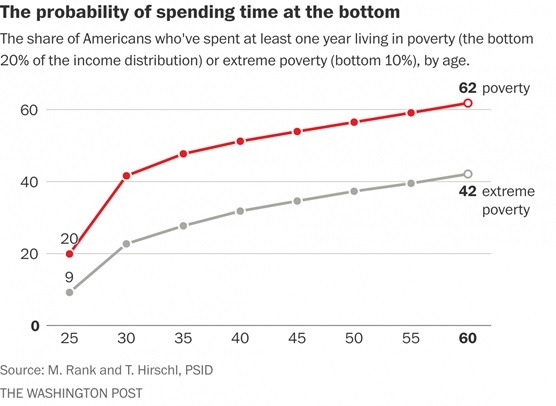
July 24, 2015; Washington Post
This week is the annual conference of the Community Action Partnership, the national trade association representing the more than 1,000 local community action agencies that are the inheritors and guardians of our nation’s commitment to the War on Poverty. That national commitment to fighting poverty has been inconsistent over recent years, but it shouldn’t have been; many of us, more than you would expect, will experience poverty at some time in our lifetimes despite the array of programs from the New Deal and then the Great Society that aim to minimize and mitigate poverty in our society.
Emily Badger and Christopher Ingraham report in the Washington Post on the research of Mark Rank, a sociologist at Washington University, whose longitudinal tracking of several thousand American households since 1968 reveals that “an incredible number…(will) experience economic insecurity.” Specifically, Rank’s data show that four out of five people experience economic hardship by the time they are 60, such as enduring time unemployed, living at least a year below the poverty level, or spending time accessing government programs for the poor such as food stamps. As the chart shows below, the experience of poverty doesn’t wait until late in life, but occurs at high levels in one’s 30s and 40s as well as 50s.

Sign up for our free newsletters
Subscribe to NPQ's newsletters to have our top stories delivered directly to your inbox.
By signing up, you agree to our privacy policy and terms of use, and to receive messages from NPQ and our partners.
“Rather than an uncommon event,” Rank says, “poverty was much more common than many people had assumed once you looked over a long period of time.” And it’s not just dipping into poverty; many Americans—roughly three out of five—actually spend time among the bottom 20 percent or even bottom 10 percent of the nation’s income distribution:

While the majority of Americans will experience some poverty in their lifetimes, only about 11 percent will spend some time, no matter how briefly, in the top 1 percent.
In other words, many of us might need to tap government anti-poverty programs at some time—because we need to, due to a slide into poverty. How does that comport with opinion polls that consistently show Americans hostile to government spending on poverty?
- A 2012 Rasmussen Reports poll revealed that 51 percent of respondents thought the U.S. spends too much on poverty programs, up from 38 percent a year earlier; only 21 percent felt that the government doesn’t spend enough to address poverty.
- This year, Gallup reported that only 16 percent of Americans were “satisfied with the work the federal government is doing to address poverty,” a new low in Gallup’s 15 years of measurement on this indicator. There was little difference on this indicator by race, gender, education, or age of respondents, and even on ideology, 16 percent of self-described conservatives and 17 percent of liberals expressed satisfaction with the government’s anti-poverty work.
- A national Pew Research Center poll indicated that 44 percent of respondents thought that “poor people have it easy because they can get government benefits without having to do anything in return,” and 63 percent believe that “blacks are mostly responsible for their own condition,” as opposed to racial discrimination.
- The polls are similar at the state level. A Texas poll in 2014 found 52 percent of respondents ascribing poverty to the choices of individuals, but only 32 percent to a lack of opportunity. (Eleven percent said “both.”) Only 35 percent believed that expanded government intervention and programs would help reduce poverty. Just six percent of New York voters in a Marist College poll from 2014 thought poverty should be the top priority of the governor.
National nonprofit leadership organizations have launched efforts to promote the efficacy and importance of human service delivery, and will do so in the future. That is important work, but these entities must demonstrate to the majority of Americans that anti-poverty programs aren’t simply for “other people” but are likely to be needed and potentially used by four-fifths of Americans at some time in their lives. That’s why it’s crucial that community action agencies convene to overcome the myopic idea of too many Americans that poverty programs are for people who don’t need them rather than serving as vital safety nets for people that might include your neighbors, you, and me. —Rick Cohen












